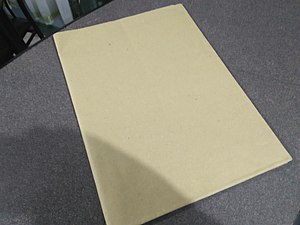| Manila paper | |
|---|---|
 A sheet of manila paper | |
| Material type | Paper |
| Physical properties | |
| Density (ρ) | ≥0.70 |
| Mechanical properties | |
| Tensile strength (σt) | ≥3.5 |
Manila paper (Spanish: 'Papel de Manila') is a relatively inexpensive type of paper, generally made through a less-refined process than other types of paper, and is typically made from semi-bleached wood fibers.
The manila component of the name originates from manila hemp (a.k.a. abacá leaves), which was named after Manila, the capital of the Philippines.[1] Beginning in the 1840s, recycled abacá rope fibers were the main material for manila paper.[2]
Before the end of the 20th century,[when?] papermakers replaced the abacá fibers with wood pulp,[3] which cost less to source and process.[4] Despite the change in production material, "the name and color remain."[4]
Since at least 1915, manila paper has been shaped to create manila file folders and manila envelopes.[5]
- ^ "An ode to filing". Otago Daily Times Online News. 11 June 2018. Retrieved 13 December 2021.
- ^ Wordsmith, Chrysti (2013-04-12). "Word of the Week: Manila envelope, a holdover from Philippine fiber". Bozeman Daily Chronicle. Retrieved 2022-09-21.
- ^ "An ode to filing". Otago Daily Times Online News. 11 June 2018. Retrieved 13 December 2021.
- ^ a b "A Manila Envelope: The Inspiration behind an Exhibition's Graphic Identity". The Guggenheim Museums and Foundation. Retrieved 2023-10-27.
- ^ Knox, Frank M. (January 1965). The Knox standard guide to design and control of business forms. McGraw-Hill. ISBN 9780070352513.